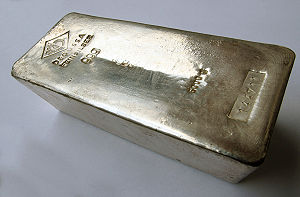 |
| A gold-standard 1928 one-dollar bill. It is identified as a "United States Note" rather than a Federal Reserve note and by the words "Will Pay to the Bearer on Demand," which do not appear on today's currency. This clause became obsolete in 1933 but remained on new notes for 30 years thereafter. (Photo credit: Wikipedia) |
Or, if you prefer, the available supply of silver is decreasing as demand soars. Some even say that demand has outstripped supply for years. Have not been able to locate the issue, but recall that the Kiplinger Letter in the 1980's was pushing short supply narrative sighting increased demand due to film used in cameras and increasing demand from China.
How about this one? The massive U.S. government debt is unsustainable and will lead to an existential crisis (e.g., Dollar collapse) that will pull the rug out from the Dollar and send the metals to the moon.
COMEX default, gold-backed Yuan, precious metals prices falling below mine cost of production, manipulation, Armageddon...and the list of narratives seemingly goes on ad infinitum.
Barry Ritholtz writes that "Everybody loves a good story". While he opens his story referring to Wall Street, it applies equally to gold and silver.
When it comes to storytelling, we have a long and venerable history of narrative. The spoken word emerged millennia ago — before even the Greeks — when the only way to share knowledge was verbally, person to person, generation to generation.It is in your DNA to love a good story. You know, neat tales with heroes and villains and conflicts to resolve. A good story pushes our buttons, is exciting and memorable.It should come as no surprise that Wall Street also loves a good story. And when Wall Street spins a yarn, its emotional pitch drives sales.
Ritholtz later continues:
Of course, many of these stories turn out to be wrong. Surprisingly, that is not what gets us into trouble as investors. As it turns out, it doesn’t matter whether a story is true or false. It may be counterintuitive, but even true stories can end up being money-losers.
What matters most to you as an investor is the entire concept of the narrative. You have a natural tendency to want an emotionally satisfying tale — and to make investments based on that — despite times when the actual data may be telling you something different.
The fear trade doesn't seem to be panning out. Stocks climbed, gold fell. It appears that the economy can teeter on the edge of a precipice for longer than many anticipated.
None of this is to say that gold and silver prices won't eventually end up much higher. At the same time, it's a valuable exercise to, from time to time, examine the stories you listen to, believe, tell others, and most importantly - the ones you tell yourself. What if those stories are wrong? What if you're missing some important detail?
A good story is enjoyable to listen to. A story can clarify or cloud our understanding. It can even make us feel better about ourselves. But, believing the wrong story can cost us dearly.




















































